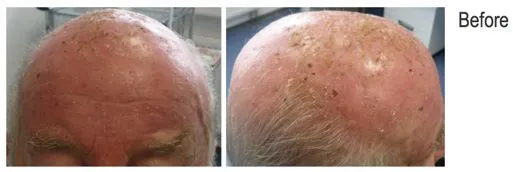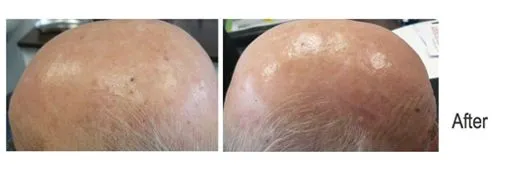Photodynamic Therapy (PDT)
Photodynamic Therapy, or PDT, is a treatment used mainly for the treatment of skin pre-cancers (called Actinic Keratosis) and has FDA approval for the treatment of these rapidly dividing skin pre-cancers. It is also commonly used off-label for facial skin rejuvenation, as well as the treatment of mild to moderate acne.
What is PDT and how does it work?
PDT utilizes Levulan or Ameluz (Aminolevulinic acid 20%), a naturally occurring photosensitizing compound, to create a photochemical reaction that selectively destroys cancer cells. Levulan or Ameluz is applied to the skin and subsequently “activated” by specific wavelengths of light. This process of activating Levulan or Ameluz with light is termed Photodynamic Therapy. In the body, Levulanic acid concentrates in skin pre-cancer cells and only becomes active when light of a certain wavelength (Blue light or Red light) is directed onto the area of the pre-cancer. The reaction between the Levulan or Ameluz and the activating light kills the pre-cancer cells.
What is a typical PDT session like?
For the treatment of skin pre-cancers with PDT, there are 3 main stages:
- Stage 1:
- A photosensitizing agent is applied to the treatment area (i.e.-Levulan, Ameluz).
- The skin may be gently debrided beforehand to increase the amount of the drug absorbed.
- Wait a certain period of time (average 3 hours, depending on the area being treated) to allow the Levulan or Ameluz to concentrate in the pre-cancer cells.
PLEASE AVOID SUN EXPOSURE DURING YOUR WAIT.
- Stage 2:
- Blue or Red light is shone directly on the treatment area
- Treatment lasts around 10-15 minutes
- Treatment area is cleaned and aftercare lotion and sunscreen are applied
- Stage 3:
- A sunburn-like reaction usually occurs, which usually heals between 1-6 weeks
Post PDT care
If your face and/or scalp are being treated, bring a large floppy hat to wear home. Wear a long-sleeved shirt if your arms are to be treated.
After the procedure, we recommend you return home and take it easy. Strict sun and fluorescent lights avoidance is recommended for at least 36 hours after treatment. If you choose to go to work after the PDT treatment please make sure you do not have fluorescent lights at work as it will intensify the process. Redness, scaling and slight swelling are common symptoms immediately following treatment. During the next 24-48 hours, swelling continues and redness may increase. Itching and mild to moderate pain may occur. During day 2-7, symptoms of flakiness, crusting and rarely blistering are possible. This period is often described as an intense sunburn-like reaction. Healing has occurred when redness and scaling is no longer present (generally -10 days). Longer pigmentation changes (increase or decrease of color) may occur in 1% of patients with most resolving in one month. Scarring and permanent pigment changes are extremely rare.
-Plan to have more than one procedure. Most patients require 2-3 treatments for total clearance of the precancerous lesions.
What are the side effects of PDT?
Side effects from the PDT are due to the sensitivity of the treated area to light. The photosensitivity of the treatment area to light usually lasts around 2 days (48 hours). Side effects may include burning/stinging sensation, swelling and redness, crusting of the treatment area, itchiness, peeling and blisters, and rarely skin infections.
The treated area should be protected from light for 48 hours. The treated area may blister and ulcerate as the pre-cancer cells die off. This may take several weeks to heal. Scarring is generally minimal, but the loss of pigmentation may occur and can be permanent.
Before & After Photos


